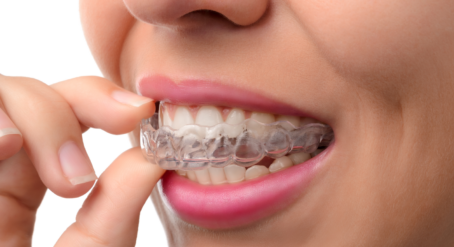Having a straight and healthy smile is an investment in your future, but it can be quite costly for some Australians. And without an initial consultation, it’s near impossible to determine the full cost of braces.
This is because the cost of orthodontics depends on several factors, including the type of treatment you need and whether you have health insurance or not. And we’re going to explain what goes into the cost of braces so you can decide if braces or clear aligners are the right solution for you or your family.
Is orthodontic treatment worth the money?
Put simply, orthodontic treatment is well worth the investment. Not only will you have straight teeth for life, but you’ll also have more confidence with your smile. If you or your family member experienced discomfort due to crooked teeth or a misaligned jaw, you can experience life pain-free once the treatment is over.
You will also save plenty of money down the track if you invest in orthodontic treatment sooner rather than later. The more you let your teeth and jaw problems get worse, the more you’ll have to pay in orthodontic treatments to fix it in the future.
What is the cost of braces in Australia?
Without an initial consultation, it’s near impossible to determine the full cost of braces. This is because the cost of orthodontics depends on several factors including the duration and complexity of treatment and the type of treatment you choose. That said, here is a guide for what you can expect to pay for a full course of orthodontic treatment in Australia:
- Metal braces (traditional braces): $6,000 – $9,000
- Ceramic braces: $6,500 – $9,500
- Lingual braces: $9,500 – $15,000
- Clear aligners: $6,500 – $9,500
* Note these prices are typically for a 15 to 18 month treatment period that not only straightens teeth, but helps to correctly align the jaw as well, and includes the cost of regular consultations to monitor the progress of your treatment.
Orthodontics Australia recommends you always consult a specialist orthodontist before undergoing any type of treatment including clear aligners, to better understand if your preferred option or limited treatment will be suitable and safe for your smile in the long term.
Of course, fees may differ if other appliances are needed in conjunction with braces, such as expansion plates, anchorage implants or bite correcting springs.
Is there a cheaper alternative to braces?
Limited treatment is a cosmetic treatment that only fixes the appearance of the front teeth, instead of fixing bite or tooth issues. Some orthodontists offer this short treatment (usually 6 months), with costs ranging from $3,500–$6,000. However, this treatment only improves the look of your smile in the short-term, rather than address any underlying issues. This can cause ongoing discomfort, complications or even a relapse in the future.
We understand that braces are a large financial investment, so it may be tempting to get cheap braces from a general practitioner. But it’s important that you always see a registered orthodontist for all your orthodontic needs and prioritise the health and safety of your teeth over the cost. In fact, orthodontic treatment delivered by a less qualified general dentist can end up costing more than the same treatment provided by a specialist orthodontist.
While cheap braces from a less qualified general practitioner might seem appealing, it is important that you always see a registered specialist for all your orthodontic needs and prioritise the health and safety of your teeth over the cost. In fact, orthodontic treatment delivered by a less qualified general dentist can end up costing more than the same treatment provided by a specialist orthodontist.

How do you pay for braces?
Since braces are a significant financial investment, many orthodontists are happy to develop a payment plan to make your treatment more affordable. This can help alleviate some financial stress and ensures you’re able to get the best treatment for you or your child.
There are also other ways you can pay for braces to lighten the financial burden and make a full course of treatment more affordable. These include:
- Paying for your treatment up front (often with a discount).
- Using a payment plan to make your repayments over time, spreading out the overall cost of treatment.
- Using third-party payment programs, like Afterpay or Klarna.
Are braces covered by Medicare?
Contrary to popular belief, orthodontic treatments are not covered by Medicare. However, if you have private health insurance you might be covered for braces depending on your policy, provider and level of extras cover. Orthodontic treatment generally isn’t covered by basic extras cover, so you’ll usually need a higher level of cover to receive a rebate.
And if you’re looking for a government scheme that might help with the cost of braces, then unfortunately there are no programs in Australia. There is, however, the Australian Government’s Child Dental Benefits Schedule (CDBS), which helps give young people aged between 0–17 access a range of dental services and procedures for free. However, benefits for orthodontic treatment such as braces aren’t covered under the CDBS.
How much do braces cost with a Health Care Card?
If you are a Health Care Card or Pension Card holder, then your child might be eligible for the Give a Smile program. The Give a Smile program helps children who might not have easy access to orthodontic treatment to get the support they need to have the perfect smile.
This program requires parents of the child to be holders of either a Health Care Card or Pension Card. Your child must also be already on a waiting list for public dental service in the state or territory that you live in. When receiving treatment through the Give a Smile program, you will either pay no fees or a small fee if you’re in certain parts of the country.
How do I know I’ve been quoted the right price by my orthodontist?
As with any investment, it’s important to do some research beforehand. Prices can vary depending on the work being done, the treatment option you have chosen and where you live in Australia. As each orthodontist is free to set their own fees, there will inevitably be some variation in the amounts each practice charges for their services.
The best way to check you’ve been quoted a decent price is to obtain an all-inclusive quote from a couple of local orthodontists. Obtaining an all-inclusive financial quote in writing and a comprehensive diagnostic report from your orthodontist is the easiest way to avoid confusion and unexpected costs. In order to compare quotes for cost-effectiveness, you should have a clear idea of what it includes.

What is included in my orthodontic fee?
You should ask your orthodontist whether the quote includes the following:
- Consultations, pre-treatment reviews and orthodontic record taking
- Orthodontic appliances
- Retainers (including replacement retainers)
- Post-treatment reviews
If you want to get the ball rolling on your orthodontic treatment, then you can use our Finder Tool to find your local orthodontist and request a consultation.











Want to tighten my braces got from overseas, how much I would be charged for it?
Hi.
We are Australians currently living in the USA on a Australian Gov posting. My 8 year old son has seen a USA orthodontist and they have recommended treatment to start soon and quoted $4000 USD for 12 months work. I would like to know this is a comparable price to pay in relation to the average prices in Canberra, Australia. Can you help me?
Kind Regards,
Janice.
Hi Janice,
We asked Dr Ray Te Moananui from Canberra to help us answer your question. Unfortunately, since orthodontic costs can vary depending on the specific needs of the patient, as well as the duration and type of treatment required, he would need more information to provide an accurate quote. Generally speaking, the maximum for Phase 1 treatment is about $3000 in Australia, and there is often the need for Phase 2 treatment when they’re older as well. You can contact Dr Ray, or use the ASO finder tool to find another registered specialist orthodontist in your area to provide further information and arrange a quote. However, you should be aware that it can be difficult to give an accurate quote without an initial appointment and the pricing may vary if your Australian orthodontist believes an alternative treatment plan would be better suited to your son. We hope that helps!
My child needs braces
Good information. Lucky me I found your website by accident
(stumbleupon). I have bookmmarked it for later!
Hi,
How much will it cost for braces adjustments?
I have my braces from outside Australia and will be staying in Australia for few months for study.
Thank you.
Hi Elaine,
Consultation fees can vary, so you will need to request the information from your chosen orthodontist. Please remember to have your regular orthodontist get in touch with their Australian counterpart prior to your first appointment so they can share their treatment plan, x-rays and any other important information to ensure your treatment stays on track.
If I have braces from overseas then how much does it cost for metal braces adjustments in Melbourne? Thank you.
Orthodontic costs may vary from practice to practice. You can use our Finder Tool to search for an orthodontist near you and to enquire about their fees.
Hi, how much does a regular check up visit cost? I already have braces.
There’s no set appointment fee for the orthodontics industry as a whole. As with any medical practitioner, the fees may vary based on a number of factors including location and operational costs. In addition, some orthodontists offer complete packages which include appointment fees. It’s best to get in touch with your current orthodontist about your fee schedule, or reach out to another orthodontist in your area using our Finder Tool: https://finder.orthodonticsaustralia.org.au/
Very educative article, learned a lot. So glad I
found your blog, and was able to learn new things. Keep posting articles, it’s really valuable.
Best regards,
Balle Raahauge
I saw your reply mentioned that the maximum price for phase 1 treatment in Canberra is around $3000. Is the price includes all follow up consultations plus the appliance? I would like to know if orthodontist in Sydney will charge at similar price range. My 7.5 year old son has seen Hong Kong orthodontist and they have recommended him phase 1 for one year. I wonder whether I should start the treatment first in HK and do the follow up in Sydney?
Hi Connie, All prices we list are approximations and there are lots of factors that may affect the cost of your treatment. However, most orthodontists will provide a full quote including the cost of the appliance and follow-up appointments, this allows their patients to plan their treatment or organise a payment plan to spread out the costs. It is always best to check with your orthodontist for more information about your quote.
Hi,
I’m currently looking to get some braces. I have tried to get invisiline only to be told I cannot due to the severity of my crowded teeth. I’m currently in year 12 and I simply cannot afford the majority of treatments, as my family is located in a rural area of Australia. What can I do?
Hi Lizzy,
Thanks for reaching out. We understand braces are a costly investment in your future, but it’s great to see you’re taking taking these initial steps towards seeing a specialist orthodontist! It might be worth giving our article Spreading the cost: Braces Payment Plans in Australia a read. It helps to outline all possible payment options, and is a great starting point to discuss with a orthodontist near you, to see if they offer these payment solutions. Our Finder tool is also another great asset for helping you locate suitable Orthodontists within your region, who would be more than happy to jump on the phone with you to answer some of your initial queries.
Hi I’m looking for a quote for my son to have braces. I might need all 3 kids done 🤦♀️ but he is ready and needs them. He is 12. I have had a quote and I am not very happy with it. Can I make an appointment please? Better to contact me by phone 0409881616
Thanks Christie
Hi Christie,
At Orthodontics Australia we don’t provide any orthodontic services directly. To find an orthodontist near you to assist with your braces treatment visit our Finder tool and get in touch with your chosen provider. They will be able to provide you with more detail around appointments, costs, and potential treatment or payment plans.
You can access our Finder Tool here: https://finder.orthodonticsaustralia.org.au/
We hope this helps!
Hi
I’m a single parent on low income,how do I receive assistance with payment for braces for my child?
Hi Mel,
Orthodontics is not covered by Medicare, and may only be partially covered by some private health insurers. You can speak to your orthodontist about the payment plans available and how they can spread the cost of your child’s treatment over several years.
We hope this helps!
I am 58 yrs old and have always wanted to straighten my teeth .
I am in a position financially to potentially have this done .
Is it worth having top & bottom braces at my age ??
What does the research show ??
Would I see results or do the teeth tend to move back to the original position ??
Regards
Danielle
Hi Danielle,
Medicare doesn’t currently cover orthodontic treatment in Australia. And when it comes to the cost of treatment, there is no ‘one size fits all’ response’. The severity of your malocclusions and even the type of treatment you get can change the cost from person to person. The best way to get an accurate quote is to consult a specialist orthodontist.
To find an orthodontist near you can use our Finder Tool: https://finder.orthodonticsaustralia.org.au/
Thanks!